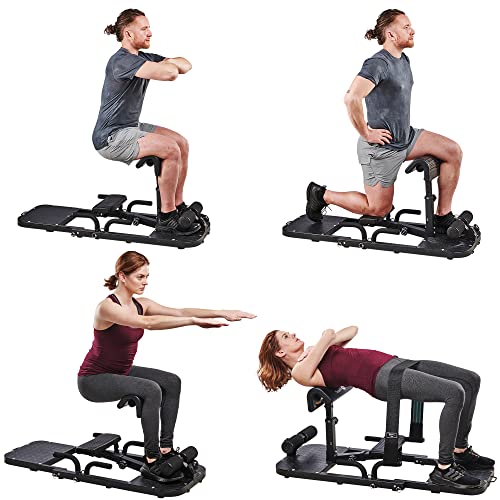Strong glutes are crucial for optimal running performance and injury prevention. The gluteus maximus, the largest muscle in the human body, plays a vital role for runners by providing power and stability during the push-off phase of each stride. Insufficient glute strength can lead to inefficient form and increase the risk of injury, as other muscles in the legs may compensate. Furthermore, strong glutes can alleviate common injuries such as iliotibial band syndrome and patellofemoral pain syndrome by stabilizing the pelvis and reducing knee stress.
So, how can runners strengthen their glutes? Many exercises can be incorporated into a training routine to target this muscle group, including squats, lunges, hip thrusts, and deadlifts. Additionally, incorporating plyometric exercises, such as box jumps and jumping lunges, can help to improve explosive power in the glutes.
Here are five ways to improve your glutes for better runs:
Squats
Squats are a highly effective exercise for strengthening the glutes and improving the runner’s performance. When performing squats, the glutes are heavily activated as they work to extend the hips and drive the body upwards. This movement pattern mimics the push-off phase of each stride in running, making squats a specific and functional exercise for runners.
Strengthening the glutes through squats can help to generate more power during runs, leading to increased speed and efficiency. Additionally, squats also engage the quadriceps and hamstrings, which can improve overall lower body strength and stability. As a result, runners who incorporate squats into their training program may experience an improvement in their form and decreased risk of injury.

See Also: Glute Strengthening For Runners: How To Get Started
Lunges
Lunges are another beneficial exercise for improving glute strength for runners. Lunges work the glutes by requiring them to extend the hips and stabilize the pelvis as the body lowers down toward the ground. This movement pattern closely resembles the mechanics of running, making lunges a highly functional exercise for runners.
In addition to the glutes, lunges also engage the quadriceps and hamstrings, which can contribute to improved lower body strength and stability. By strengthening the glutes and other muscles involved in running, lunges can help to enhance their form, increase power, and reduce the risk of injury. Runners who regularly perform lunges may also notice improvements in their balance, coordination, and agility, which can further benefit their overall performance.
Glute Bridges
Glute bridges are an excellent exercise for specifically targeting the gluteus muscle. When performing glute bridges, the glutes are engaged to lift the hips toward the ceiling, creating a strong contraction in the muscles. This exercise helps to develop our glute strength and endurance, both of which are crucial for a runner’s performance.
Additionally, glute bridges also engage the hamstrings, which play an important role in stabilizing the pelvis during runs. Strengthening these muscles can help to reduce the risk of injury and improve overall lower body strength and stability.
By regularly incorporating glute bridges into their training program, runners can expect to see improvements in their form, speed, and efficiency. They may also experience less fatigue and soreness in the glutes and other lower body muscles during long-distance running, allowing them to perform better and recover faster.
See Also: 5 Best Hip Stretches To Pave Your Way To Better Runs
Step-Ups
Step-ups are another effective exercise for improving glute strength and running performance. This exercise targets the glutes by requiring them to contract to lift the body onto a step or bench. Additionally, step-ups also engage the quadriceps and hamstrings, which can help to improve overall lower body strength and stability. The movement pattern of step-ups mimics the mechanics of running, making this exercise highly functional for runners.
By strengthening the glutes and other muscles involved in running, step-ups can help to enhance a runner’s form, increase power, and reduce the risk of injury. Furthermore, step-ups can be easily modified to increase or decrease the challenge, making them suitable for runners of all fitness levels. By incorporating step-ups into their training program, runners can expect to see improvements in their glute strength, balance, and coordination.
Plyometric Exercises
Plyometric exercises are explosive movements that involve jumping, hopping, and bounding. These exercises are particularly effective for improving your runs as they help to develop power, speed, and explosive strength in the lower body.
Plyometric exercises specifically targeting the glutes, such as squat jumps and box jumps, can help to strengthen these muscles and improve a runner’s efficiency. Additionally, plyometric exercises can help to improve overall coordination and balance, which can further enhance your runs.
However, it’s important to note that plyometric exercises are high-impact and require a certain level of fitness and coordination to perform safely. Runners should only attempt plyometric exercises once they have built a solid foundation of strength and have received proper instruction from a qualified fitness professional. When performed correctly, plyometric exercises can be an effective addition to a runner’s training program and can help to take their running to the next level.
See Also: Why Strengthening Your Glutes Is Important for Faster Running
Conclusion

In conclusion, strong glutes are a vital component of a runner’s overall fitness and can help to improve their performance, reduce the risk of injury, and promote overall health and well-being. By incorporating targeted exercises into their training regimen, runners can develop strong, powerful glutes that will help them achieve their goals and perform at their best.
















